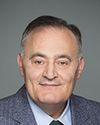Good afternoon, everyone.
Welcome to meeting number 16 of the House of Commons Standing Committee on Transport, Infrastructure and Communities.
Today's meeting is taking place in a hybrid format, pursuant to the House order of January 25, 2021. The proceedings will be made available via the House of Commons website. So you are aware, the webcast will always show the person speaking rather than the entirety of the committee.
To ensure an orderly meeting, I would like to outline a few rules to follow. First off, members and witnesses may speak in the official language of their choice. Interpretation services are available for this meeting. You have the choice at the bottom of your screen of floor, English or French.
For members participating in person, proceed as you usually would when the whole committee is meeting in person in the committee room. Keep in mind the directives from the Board of Internal Economy regarding masking and health protocols.
Before speaking, please wait until I recognize you by name. If you are on the video conference, please click on the microphone icon to unmute. For those in the room, your microphone will be controlled as normal by the proceedings and verification officer. I remind everyone that all comments by members and witnesses should be addressed through the chair.
Finally, when you are not speaking, your mike should be on mute.
With regard to a speaking list, as always, the committee clerk and I will do the very best we can to maintain the order of speaking for all members, whether they are participating virtually or in person.
With that, pursuant to Standing Order 108(2) and the motion adopted by the committee on Tuesday, January 26, 2021, the committee is meeting today to continue its study on the aircraft certification process.
I will now welcome and introduce our witnesses for today. From the Department of Transport, we have Nicholas Robinson, director general, civil aviation; and David Turnbull, director of national aircraft certification. They are by no means rookies to this committee. This is not the first time they've sat in those seats as witnesses. All of us are very familiar with these two witnesses.
With that introduction, I am now going to turn it over to the witnesses, for five minutes each, to introduce themselves as well as give their testimony.
Mr. Robinson and Mr. Turnbull, the floor is yours.



